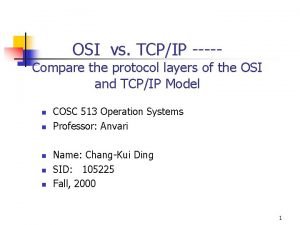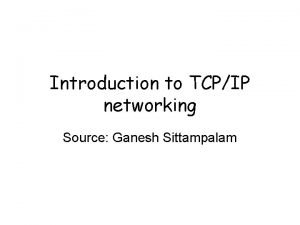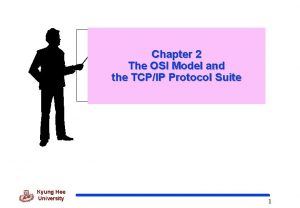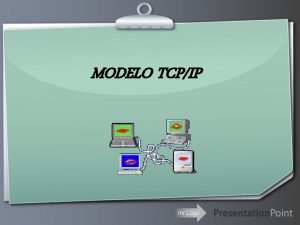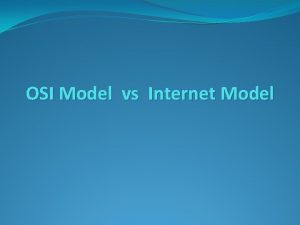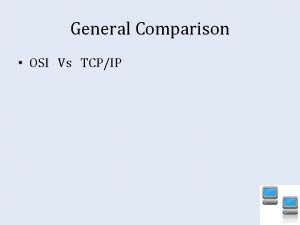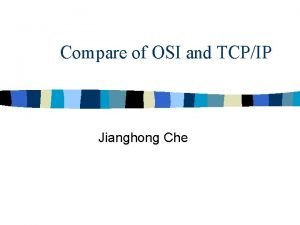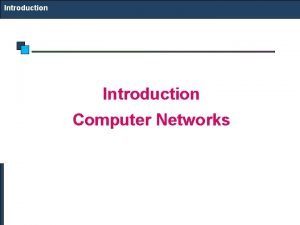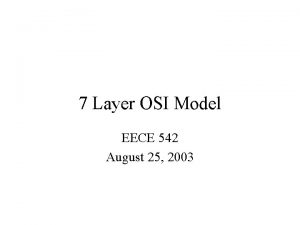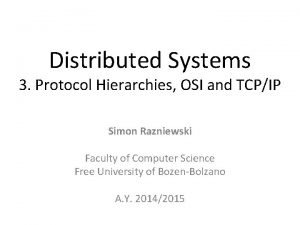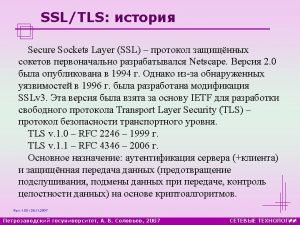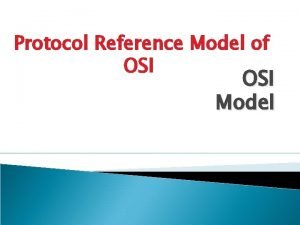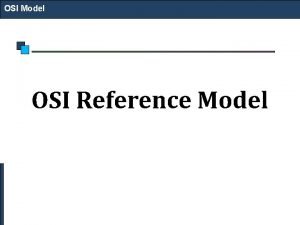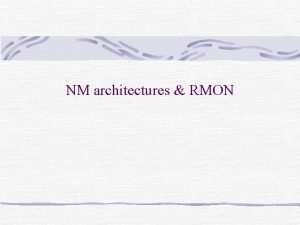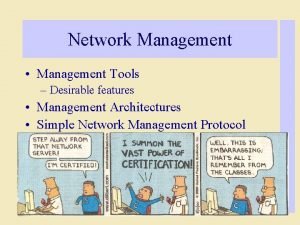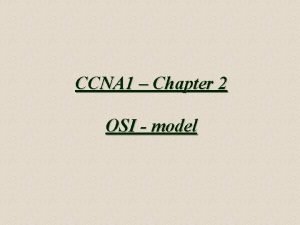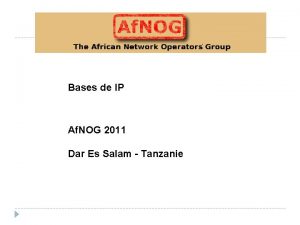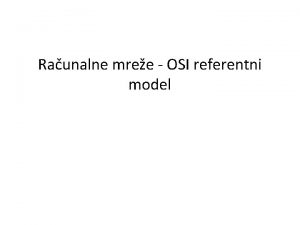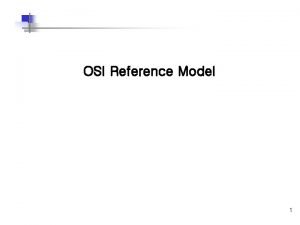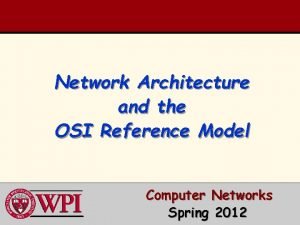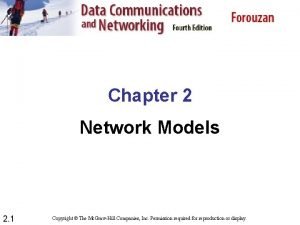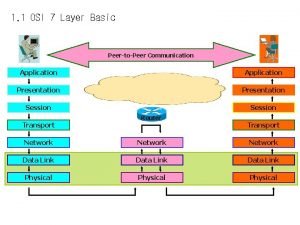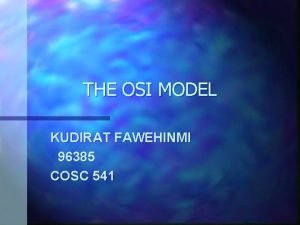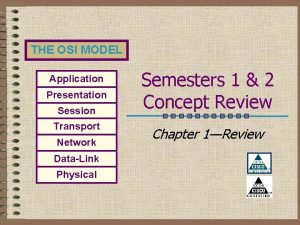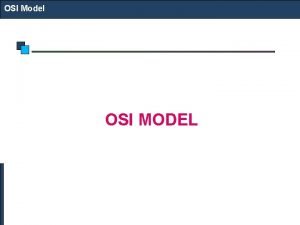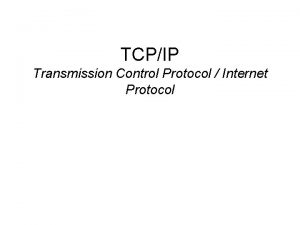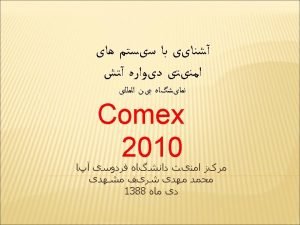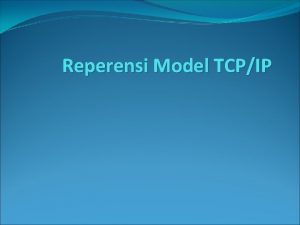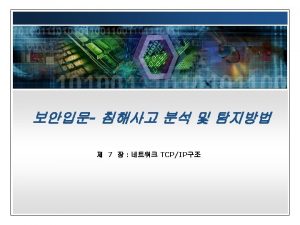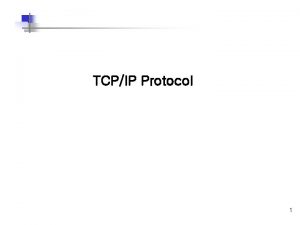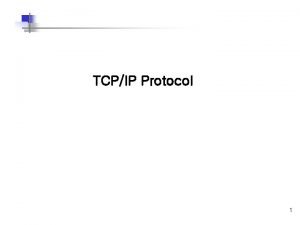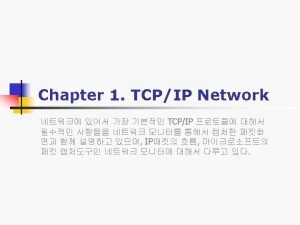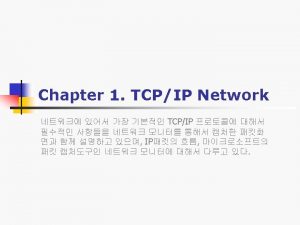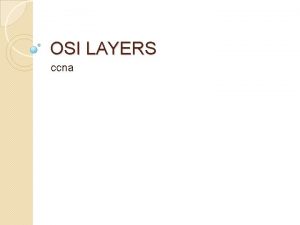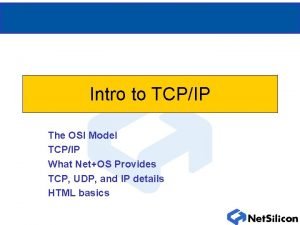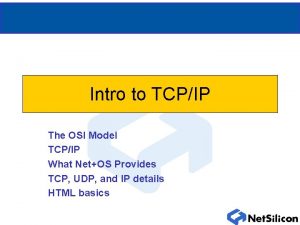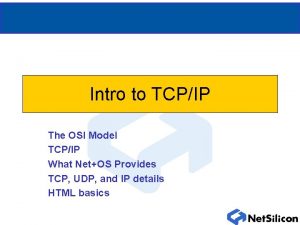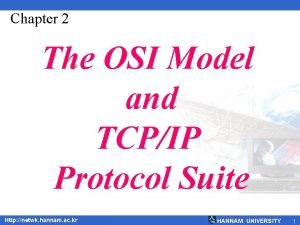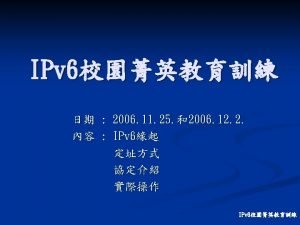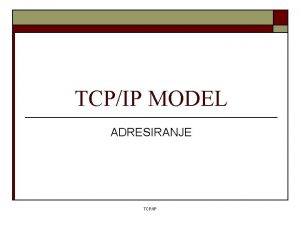Chapter 2 The OSI Model and TCPIP Protocol








































- Slides: 40

Chapter 2 The OSI Model and TCP/IP Protocol Suite Mc. Graw-Hill ©The Mc. Graw-Hill Companies, Inc. , 2000

CONTENTS • THE OSI MODEL • LAYERS IN THE OSI MODEL • TCP/IP PROTOCOL SUITE • ADDRESSING • TCP/IP VERSIONS Mc. Graw-Hill ©The Mc. Graw-Hill Companies, Inc. , 2000

2. 1 THE OSI MODEL Mc. Graw-Hill ©The Mc. Graw-Hill Companies, Inc. , 2000

ISO is the organization. OSI is the model. Mc. Graw-Hill ©The Mc. Graw-Hill Companies, Inc. , 2000

Figure 2 -1 OSI Model Mc. Graw-Hill ©The Mc. Graw-Hill Companies, Inc. , 2000

Figure 2 -2 Mc. Graw-Hill OSI layers ©The Mc. Graw-Hill Companies, Inc. , 2000

Headers are added to the data at layers 6, 5, 4, 3, and 2. Trailers are usually added only at layer 2. Mc. Graw-Hill ©The Mc. Graw-Hill Companies, Inc. , 2000

Figure 2 -3 Mc. Graw-Hill An exchange using the OSI model ©The Mc. Graw-Hill Companies, Inc. , 2000

2. 2 Mc. Graw-Hill LAYERS IN THE OSI MODEL ©The Mc. Graw-Hill Companies, Inc. , 2000

Figure 2 -4 Physical Layer Mc. Graw-Hill ©The Mc. Graw-Hill Companies, Inc. , 2000

Physical layer • • 1. 2. 3. 4. 5. 6. 7. Mc. Graw-Hill responsible for movements of individual bits from one hop to the next The physical layer also concern with the following: Physical characteristics of interface and medium. Representation of bit: define the type of encoding. Data rate : the number of bit sent each second. Synchronization of bits: it must be synchronized at the bit level Line configurations : concerned with the connection of devices to the media. Physical topology: how device can connected to make a network. Transmission mode: define the direction of transmission ©The Mc. Graw-Hill Companies, Inc. , 2000

Figure 2 -5 Data Link Layer Mc. Graw-Hill ©The Mc. Graw-Hill Companies, Inc. , 2000

Data link • • 1. 2. 3. 4. Mc. Graw-Hill responsible for moving frame from one node to the next. Other responsibilities to the data link layer : Framing. Physical addressing. Flow control. Error control. ©The Mc. Graw-Hill Companies, Inc. , 2000

Figure 2 -6 Node-to-node delivery Mc. Graw-Hill ©The Mc. Graw-Hill Companies, Inc. , 2000

Figure 2 -7 Network Layer Mc. Graw-Hill ©The Mc. Graw-Hill Companies, Inc. , 2000

Network layer • The network layer is responsible for the delivery of individual packets from the source host to the destination host. • other responsibilities of the network layer include the following : 1. Logical addressing 2. routing Mc. Graw-Hill ©The Mc. Graw-Hill Companies, Inc. , 2000

Figure 2 -8 Mc. Graw-Hill End-to-end delivery ©The Mc. Graw-Hill Companies, Inc. , 2000

Figure 2 -9 Mc. Graw-Hill Transport Layer ©The Mc. Graw-Hill Companies, Inc. , 2000

Transport layer • • 1. 2. 3. 4. 5. Mc. Graw-Hill the transport layer is responsible for the delivery of the message from one process to another. Other responsibilities of the transport layer: Service- point addressing. Segmentations and reassembly. Connection control. Flow control. Error control. ©The Mc. Graw-Hill Companies, Inc. , 2000

Figure 2 -10 Reliable end-to-end delivery of a message Mc. Graw-Hill ©The Mc. Graw-Hill Companies, Inc. , 2000

Figure 2 -11 Session Layer Mc. Graw-Hill ©The Mc. Graw-Hill Companies, Inc. , 2000

Session layer • The session layer is the network dialog controller • It establishes, maintains and synchronizes the interaction between communicating system. Specific responsibilities of the session layer: 1. dialog control : allows two system to enter a dialog. 2. synchronization point. Mc. Graw-Hill ©The Mc. Graw-Hill Companies, Inc. , 2000

Figure 2 -12 Presentation Layer Mc. Graw-Hill ©The Mc. Graw-Hill Companies, Inc. , 2000

Presentation layer • concerned with the syntax and semantics of the information exchanged between two systems. • Specific responsibilities of the presentation layer: 1. Translation 2. Encryptions 3. Compression Mc. Graw-Hill ©The Mc. Graw-Hill Companies, Inc. , 2000

Figure 2 -13 Application Layer Mc. Graw-Hill ©The Mc. Graw-Hill Companies, Inc. , 2000

Application layer • • 1. 2. 3. 4. Mc. Graw-Hill Enable the user , whether human or software to access the network. Specific services provided by the application layer network virtual terminal File transfer , access and management Mail services directory services ©The Mc. Graw-Hill Companies, Inc. , 2000

Figure 2 -14 Summary of layers Mc. Graw-Hill ©The Mc. Graw-Hill Companies, Inc. , 2000

2. 3 Mc. Graw-Hill TCP/IP PROTOCOL SUITE ©The Mc. Graw-Hill Companies, Inc. , 2000

Figure 2 -15 Mc. Graw-Hill TCP/IP and OSI model ©The Mc. Graw-Hill Companies, Inc. , 2000

2. 4 ADDRESSING Mc. Graw-Hill ©The Mc. Graw-Hill Companies, Inc. , 2000

Figure 2 -16 Addresses in TCP/IP Mc. Graw-Hill ©The Mc. Graw-Hill Companies, Inc. , 2000

Figure 2 -17 Mc. Graw-Hill Relationship of layers and addresses in TCP/IP ©The Mc. Graw-Hill Companies, Inc. , 2000

Figure 2 -18 Physical addresses Mc. Graw-Hill ©The Mc. Graw-Hill Companies, Inc. , 2000

Example 2 Most local area networks use a 48 -bit (6 bytes) physical address written as 12 hexadecimal digits, with every 2 bytes separated by a hyphen as shown below: 07 -01 -02 -01 -2 C-4 B A 6 -byte (12 hexadecimal digits) physical address Mc. Graw-Hill ©The Mc. Graw-Hill Companies, Inc. , 2000

Figure 2 -19 IP addresses Mc. Graw-Hill ©The Mc. Graw-Hill Companies, Inc. , 2000

Example 4 As we will see in Chapter 4, an Internet address (in IPv 4) is 32 bits in length, normally written as four decimal numbers, with each number representing 1 byte. The numbers are separated by a dot. Below is an example of such an address. 132. 24. 75. 9 Mc. Graw-Hill ©The Mc. Graw-Hill Companies, Inc. , 2000

Figure 2 -20 Mc. Graw-Hill Port addresses ©The Mc. Graw-Hill Companies, Inc. , 2000

Example 6 As we will see in Chapters 11 and 12, a port address is a 16 -bit address represented by one decimal number as shown below. 753 Mc. Graw-Hill A 16 -bit port address ©The Mc. Graw-Hill Companies, Inc. , 2000

2. 5 TCP/IP VERSIONS Mc. Graw-Hill ©The Mc. Graw-Hill Companies, Inc. , 2000

IP Versions: • Version 4 (current) The primary problem is that the Internet address is only 32 bits • Version 6 (future) Use 128 bit addresses Mc. Graw-Hill ©The Mc. Graw-Hill Companies, Inc. , 2000
 Osi vs tcp/ip
Osi vs tcp/ip Ganesh sittampalam
Ganesh sittampalam Tcpip model
Tcpip model History of osi model
History of osi model Tcpip
Tcpip Modelo tcpip
Modelo tcpip Diagrama tcp
Diagrama tcp Que significa
Que significa Osi model vs internet model
Osi model vs internet model Osi vs tcp ip
Osi vs tcp ip Comparison and critique of osi and tcp/ip model
Comparison and critique of osi and tcp/ip model Encapsulation and decapsulation in osi model
Encapsulation and decapsulation in osi model Which layer in the osi model covers http, ftp, and rdc?
Which layer in the osi model covers http, ftp, and rdc? Osi modell
Osi modell Why and when osi reference model was invented?
Why and when osi reference model was invented? Osi model slojevi
Osi model slojevi Osi rm
Osi rm Snmp ports
Snmp ports Conclusion of osi model
Conclusion of osi model Physical layer in osi model examples
Physical layer in osi model examples Osi network management model
Osi network management model Network management station
Network management station Network management model
Network management model Network management standards
Network management standards Osi-iso
Osi-iso X.800 security architecture
X.800 security architecture Osi model ccna
Osi model ccna Osi network management model
Osi network management model Encapsulation decapsulation osi model
Encapsulation decapsulation osi model Osi security model
Osi security model Slojevi osi modela
Slojevi osi modela The basic unit of a physical network (osi layer 1) is the:
The basic unit of a physical network (osi layer 1) is the: Networking osi model
Networking osi model Osi architecture in computer networks
Osi architecture in computer networks Seven layers of the osi model
Seven layers of the osi model Peer-to-peer communication in osi model
Peer-to-peer communication in osi model Osi model layers
Osi model layers Application presentation session transport network
Application presentation session transport network Osi model in computer network
Osi model in computer network Osi modelis
Osi modelis Modeli osi
Modeli osi
